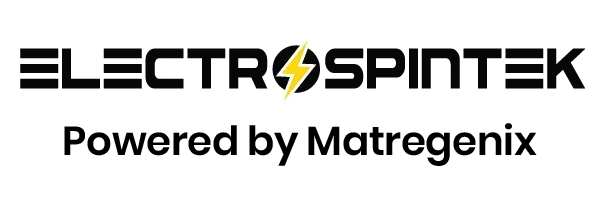If you’re diving into the fascinating world of nanofiber fabrication, chances are you’ve come across the term electrospinning PVA. This method is not only versatile but also relatively accessible, especially for researchers, innovators, and even small-scale labs. In this guide, we’ll walk you through the process of creating polymer nanofibers using electrospinning techniques, specifically with polyvinyl alcohol (PVA) a biodegradable, water-soluble polymer.
At Electrospintek, we specialize in helping researchers and manufacturers take full advantage of electrospinning technology, and today, we’re breaking it down for you.
What is Electrospinning?
Electrospinning is a fiber production technique that uses electrostatic force to draw polymer solutions into ultrafine fibers. It’s one of the most effective and scalable methods for creating nanofibers fibers with diameters in the nanometer range. The process might sound complex, but the basic setup is surprisingly straightforward.
An electrospinning setup usually includes:
- A syringe with a polymer solution (in this case, PVA),
- A high-voltage power supply,
- A spinneret or needle,
- And a grounded collector plate.
The magic happens when the electric field causes the PVA solution to form a Taylor cone, eventually launching a thin jet that solidifies into a fiber upon contact with the collector.
Why Choose PVA for Electrospinning?
So why is electrospinning PVA so popular in academic and industrial research?
Polyvinyl alcohol (PVA) is:
- Biodegradable and eco-friendly
- Water-soluble, making it easy to work with
- Non-toxic and safe for biomedical applications
- Affordable and readily available
These traits make it ideal for applications ranging from biodegradable nanofibers to medical wound dressings, filtration membranes, and drug delivery systems.
Preparing Your PVA Solution
Before diving into the spinning process, it’s crucial to prepare your PVA solution correctly. The concentration of PVA in water significantly impacts the nanofiber morphology the structure, thickness, and uniformity of the resulting fibers.
Here’s a simple recipe to get started:
- Choose the right molecular weight – PVA with a molecular weight of 85,000–146,000 works well.
- Dissolve PVA powder in distilled water – usually at concentrations of 8% to 12% (w/v).
- Stir and heat the solution at around 80°C for 2 hours or until fully dissolved.
- Let it cool to room temperature before loading it into your syringe.
Consistency is key. A well-prepared solution ensures smooth fiber formation without beads or irregularities.
Fine-Tuning Electrospinning Parameters
To produce high-quality polymer nanofibers, you’ll need to carefully control several electrospinning parameters:
1. Voltage
Typically ranges from 10–25 kV. Too low, and the jet won’t form. Too high, and the fibers may break up mid-flight.
2. Flow Rate
Maintain a steady flow usually between 0.5 to 1 mL/hour. This allows the fibers to elongate properly without merging or forming droplets.
3. Needle-to-Collector Distance
Generally set between 10–20 cm. If it’s too close, fibers may not solidify; too far, and they can scatter or thin out.
4. Ambient Conditions
Humidity and temperature also affect nanofiber morphology. Lower humidity favors smoother fibers, while high humidity can lead to porous structures.
The Role of Needle-Based Electrospinning
Needle-based electrospinning is the most common and cost-effective method for lab-scale nanofiber production. It gives precise control over fiber diameter and alignment, especially when working with polymers like PVA.
Advanced systems may use coaxial needles for core-shell fiber designs or multi-needle setups for higher throughput features available in Electrospintek’s custom systems.
Applications of Electrospun PVA Nanofibers
The beauty of electrospinning PVA lies in its sheer range of applications. These include:
- Biomedical: Wound healing scaffolds, drug delivery systems
- Environmental: Water filtration, air purification
- Textiles: Breathable, moisture-wicking fabrics
- Electronics: Sensors, flexible substrates
Because of their biodegradable nanofiber nature, PVA-based fibers are especially attractive for sustainable technologies.
Troubleshooting Common Issues
Even seasoned researchers can hit a snag. Here are a few common problems and quick fixes:
- Beaded fibers: Try increasing the solution concentration or adjusting the voltage.
- Jet instability: Check the flow rate and needle alignment.
- Clogging: Filter your PVA solution and clean the needle regularly.
- Non-uniform fibers: Calibrate the voltage and maintain steady ambient conditions.
Final Thoughts
Electrospinning PVA is a gateway into the dynamic field of nanofiber fabrication. Whether you’re in a research lab or running a pilot production line, mastering this technique opens the door to countless innovations in materials science, healthcare, and sustainability.
At Electrospintek, we’re passionate about making electrospinning accessible, customizable, and scalable. From custom-built electrospinning machines to tailored consulting services, we’re here to help you succeed at every stage of your nanofiber journey.
Ready to start your own nanofiber creation project? Reach out to Electrospintek where ideas spin into reality.
